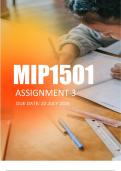Exam (elaborations)
MIP1501 Assignment 3 (COMPLETE ANSWERS) 2024 (792287) - DUE 22 July 2024 ;100% TRUSTED workings, explanations and solutions.
- Course
- MIP1501
- Institution
- University Of South Africa
Question 1 (26) 1.1. Solve and explain each step to grade 6 mathematics learners the following multiplication and division calculations involving fractions. 1.1.1. 684÷ 612 (6) 1.1.2. 714× 418 (4) 1.1.3. 316× 624 (6) 1.1.4. 817÷ 124 (4) 1.2. Modelling refers to the idea that learners build in t...
[Show more]




